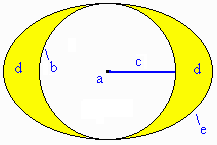
PHYSICS 1040 - ELEMENTARY ASTRONOMY - HOMEWORK #12
1. A neutron star is a very compact, dense ball of neutrons formed by the Type II supernova explosion of an intermediate-mass star. The neutrons supply the neutron degeneracy pressure that supports the star against its own gravity. However, 3 solar masses is the maximum possible mass for a neutron star. If the star has more than 3 solar masses, the neutron degeneracy pressure fails, and the star undergoes total gravitational collapse to become a black hole.
2. A rapidly rotating magnetic neutron star is called a pulsar. This star rotates so fast because the law of conservation of angular momentum says that, if the mass of an isolated object doesn't change, then its (size)2 x (rotation speed) remains constant. If a star the size of the Sun were to collapse down to the size of a neutron star (while keeping the same mass), it would become 50,000 times smaller. It would then rotate
(50,000)2 = 2.5 x 109 = 25 billion
times faster than the Sun, which means that the collapsed star would rotate 1150 times each second! This is about how fast the fastest pulsars are observed to rotate.
3. If a white dwarf is a member of a binary star system, orbiting a normal companion star, the white dwarf=s gravity may pull gas (mostly hydrogen) from the other star. This hot gas will form a rotating accretion disk around the white dwarf before spiraling down onto the white dwarf=s surface. As the hydrogen gas builds up on the surface of the white dwarf, it is compressed and heated. Finally, when the temperature of the gas reaches about 10 million K, the hydrogen gas on the white dwarf=s surface will explode in a violent nuclear fusion reaction. This is called a nova.
4. If a neutron star is a member of a binary system, orbiting a normal companion star, the neutron star's gravity may pull hot gas (mostly hydrogen) from the other star. This hot gas will form a rotating accretion disk around the neutron star before spiraling down onto the neutron star's surface. As the hydrogen gas settles onto the neutron star= s surface, it undergoes a fusion reaction into helium. As the helium gas builds up on the surface of the neutron star, it is compressed and heated. Finally, when the temperature of the gas reaches about 30 million K, the helium gas on the neutron star=s surface will explode in a violent nuclear fusion reaction. This produces the sudden increase in x-rays called a burster.
5. Einstein=s special theory of relativity us based on two principles. a) The laws of physics which describe physical reality are the same regardless of the constant speed with which you move. b) Regardless of your speed or direction of motion, you always measure the same value for the speed of light. A speed is just a length divided by an elapsed time, so these two principles predict that different observers in relative motion will disagree about their measurements of length and time.
6. According to Einstein's general theory of relativity, gravity is the result of matter moving through curved space. Matter tells space how to curve, and curved space tells matter how to move. As a star, planet, light beam, or baseball moves through this curved space, it experiences gravity. In addition, time slows down in curved space, so that clocks actually run more slowly in stronger gravitational fields!
7. A pulsar in a binary system of two neutron stars was discovered by Joseph Taylor and Russell Hulse. As the two stars orbit each other every 7.75 hours, the distance between them slowly increases/decreases (circle one). The energy the stars lose as they spiral toward each other is carried away by gravitational waves, which are ripples in the structure of spacetime.
8. This drawing shows a rotating black hole. Identify a) the singularity (the point of infinite density); b) the event horizon (where the escape velocity equals the speed of light); c) the Schwarzschild radius; d) the ergosphere (where space and time are dragged around with the rotating black hole); and e) the static limit.

9. The Schwarzschild radius of a black hole of mass M (in solar units) is R
s = M x 3 km. For the Sun, M = 1 (by definition), so the Schwarzschild radius of a one solar mass black hole is 3 km. The Schwarzschild radius of a black hole with 10 solar masses (M = 10) is 30 km. The supermassive black hole at the center of our Milky Way galaxy has a mass of about 2.6 million solar masses (M = 2.6 million = 2.6 x 106). The Schwarzschild radius of the supermassive black hole at the center of our Milky Way galaxy is 7.8 million km.
10. Because a black hole does not give off any light of its own, astronomers search for black holes in binary star systems. The black hole in a binary system may gravitationally pull gas from its companion star to form an accretion disk around the black hole. As the gas spirals in toward the black hole, it is compressed and heated so it emits x-rays. Three such x-ray sources are Cygnus X-1, V404 Cygni, and A0620-00. Using Kepler= s third law, astronomers have concluded that each of these binary systems contains a black hole.